In Taiwan, a strong earthquake hit Hualien on April 3, with the fundraising amount reaching NT$1.07 billion (approximately 0.35 billion US dollars) as of April 18. The 2024 Fulong International Sand Sculpture Art Season is set to kick off on May 31 at Fulong Beach, and the sand sculpture project has been underway since March. Japanese sand sculptors have created a piece titled “Taiwan 加油” to support the earthquake victims in Hualien, expressing gratitude to Taiwan for the assistance provided during the 311 earthquake in Japan.
The Relief Foundation under the Ministry of Health and Welfare of the Republic of China launched a fundraising project for the earthquake in Hualien on April 4, with the fundraising campaign open until May 3, lasting for a month. As of the 18th, the foundation announced that the fundraising amount had reached NT$1.07 billion, with the largest contribution coming from Japan.
Fulong Hotel posted on Facebook that the 2024 Fulong International Sand Sculpture Art Season is just around the corner, and the project has been in full swing since March, scheduled to officially debut on May 31. Japanese sand sculptors Toshihiko Hosaka and Mari Hayashi are also taking part in the sand sculpture creation. Despite facing the significant disaster of the Hualien earthquake on April 3 during the creative process, they specially crafted the “Taiwan 加油” sand sculpture to encourage the people of Taiwan to rebuild their homes swiftly and resolutely.
Hosaka, who has participated in the Fulong Sand Sculpture Art Season for over a decade, expressed his gratitude for Taiwan’s support following the 311 earthquake in 2011, where Taiwan was the first to extend aid to Japan globally. He had previously created a sand sculpture thanking Taiwan for its assistance.
Regarding the recent earthquake in Taiwan, Hosaka stated, “The earthquake in Japan in 2011 turned East Matsushima City in Miyagi Prefecture into a severe disaster area, resulting in the unfortunate loss of many lives. Taiwan actively participated in the relief efforts, providing significant help in both actions and contributions, which is why I made a sand sculpture to express thanks to Taiwan back then.”
Hosaka further added, “This year, Taiwan is also facing a major earthquake. Through the power of art, I hope to convey Japan’s support for Taiwan and believe that Taiwan will overcome this challenge and rise again.”
The “Taiwan 加油” sand sculpture features the words “Taiwan 加油” in both Chinese and Japanese on the front, while the back is inscribed with messages of support and blessings for the people of Taiwan in Chinese characters. The sides depict two national birds, the Taiwan blue magpie and the Japanese green pheasant, symbolizing the connection between Japan and Taiwan. This symbolism aims to instill confidence for them to soar together once more, with hope that their spirit will never be extinguished.

